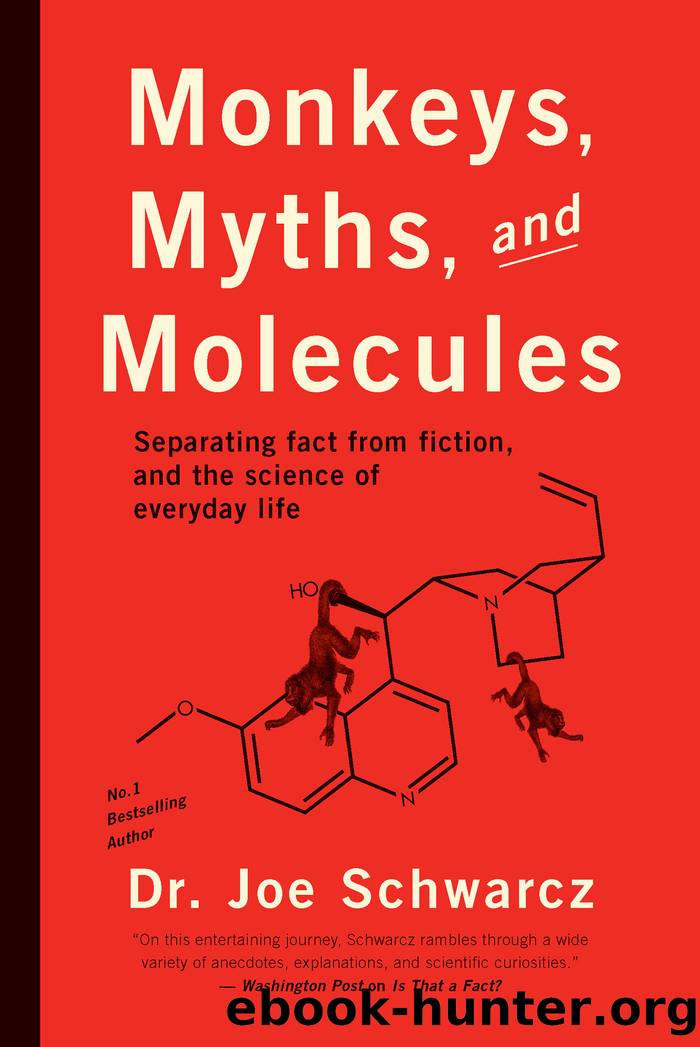Monkeys, Myths, and Molecules by Joe Schwarcz

Author:Joe Schwarcz
Language: eng
Format: epub
Tags: SCI013000
ISBN: 9781770907010
Publisher: ECW Press
Published: 2015-03-23T00:00:00+00:00
PARAXYLENE PARADOX
Chinese cities donât often see demonstrations. But the proposed building of a new chemical plant in the city of Kunming did manage to drive thousands of people into the streets in protest. Kunming may be small by Chinese standards, but it has a population of six million, many of whom donât want a giant paraxylene plant in their backyard. Theyâre worried about the release of toxic chemicals, which is understandable given that a recent analysis by the Health Effects Institute in Boston found that every year over a million people die prematurely in China due to air pollution. The fear is that the new chemical plant, on track to process 10 million tons of crude oil and produce half a million tons of paraxylene (PX for short) every year, will contribute to pollution. So, why is there a need to produce such vast quantities of a chemical that most people have never heard of? Because it is needed to make terephthalic acid, one of the main components of a substance you surely have heard of, namely, polyester!
Our life without polyester would be dramatically different. Bottles of all kinds, synthetic fibers, insulating materials and fiberglass are just some of the consumer items made from this synthetic polymer. Whenever you see the #1 recycling logo on a bottle, youâre looking at polyethylene terephthalate (PET), perhaps the most widely used polyester. Coca-Cola alone uses about one hundred billion polyester bottles a year! Thatâs about fourteen bottles for every person on Earth. Some are recycled into items such as insulation, outdoor furniture or easy to care for and comfortable microfiber fabrics. Recycling, though, cannot meet the demand for polyester, hence the need for paraxylene production.
The source for paraxylene, as it is for so many of the chemicals needed for modern life, is that mixture of hundreds of compounds formed by the slow decomposition of organic matter we call petroleum. Distillation of crude petroleum yields a mixture of liquids known as naphtha, which can be subjected to further catalytic reforming to produce benzene, toluene and a mixture of closely related compounds known as xylenes. This somewhat curious name derives from the Greek word for wood, âxulon,â because the colorless, flammable, pleasant-smelling xylenes can be obtained from the distillation of wood in the absence of oxygen. The mixture of xylenes can be refined to yield paraxylene, which in turn is converted to terephthalic acid, the compound used to make polyethylene terepthalate. Xylenes themselves are often used as paint thinners, degreasers, cleaning agents and solvents for dyes, pigments and pesticides.
There are two fundamental issues here. First, how likely is the release of chemicals from a paraxylene plant, and second, if there is some release, what is the risk? Modern chemical facilities are built according to stringent specifications and feature many safeguards. The risk of releasing significant amounts of chemicals into the environment is small, but not zero. People, however, clamor for zero risk, a fundamentally flawed concept. Pipelines can leak, trucks, trains or ships with chemical cargoes can be involved in accidents.
Download
This site does not store any files on its server. We only index and link to content provided by other sites. Please contact the content providers to delete copyright contents if any and email us, we'll remove relevant links or contents immediately.
Alchemy and Alchemists by C. J. S. Thompson(2908)
The Elements by Theodore Gray(2425)
The Club by A.L. Brooks(2350)
How to Make Your Own Soap by Sally Hornsey(2332)
Drugs Unlimited by Mike Power(2187)
Wheels of Life by Anodea Judith(1603)
Cracking the Sat French Subject Test, 2013-2014 Edition by The Princeton Review(1517)
The Cosmic Machine: The Science That Runs Our Universe and the Story Behind It by Scott Bembenek(1475)
Perfume by Jean-Claude Ellena(1464)
The Flavor Matrix by James Briscione(1359)
1000 Multiple-Choice Questions in Organic Chemistry by Organic Chemistry Academy(1346)
Cracking the LSAT, 2012 Edition by Princeton Review(1336)
MCAT Physics and Math Review by Princeton Review(1301)
Cracking the SAT Premium Edition with 6 Practice Tests, 2017 by Princeton Review(1248)
Synchrotron Light Sources and Free-Electron Lasers by Eberhard J. Jaeschke Shaukat Khan Jochen R. Schneider & Jerome B. Hastings(1233)
Handbook of Modern Sensors by Jacob Fraden(1220)
A is for Arsenic: The Poisons of Agatha Christie (Bloomsbury Sigma) by Kathryn Harkup(1210)
Harry Potter All Books: 8 Books by J.k.rowling(1185)
Cracking the AP English Language & Composition Exam, 2018 Edition by Princeton Review(1030)
